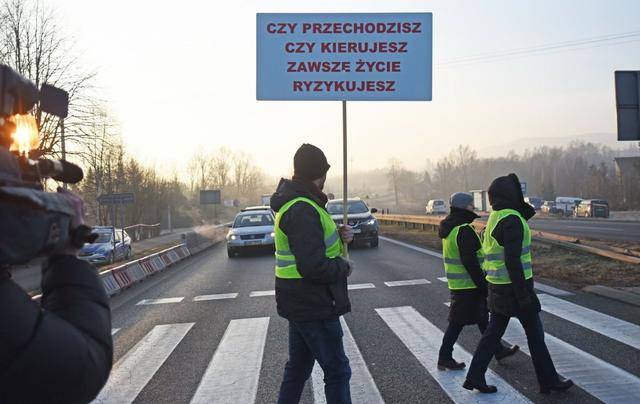Nothing came of it - the idea was torpedoed not only.The problem is that the word has been said, and - as is well known - the Polish prime minister does not say words to the wind...
The solution to the storm situation ensuring the prime minister to go out with the face is a new project, which - as we read on the official pages of the Ministry of Infrastructure - "improves pedestrian safety".So did Prime Minister Morawiecki keep his promise made in expose?NO!
advertisement
We read in the project (we have marked the changes with bound) M.in., że: "Kierujący pojazdem, zbliżając się do przejścia dla pieszych, jest obowiązany zachować szczególną ostrożność, zmniejszyć prędkość tak, aby nie narazić na niebezpieczeństwo pieszego znajdującego się na tym przejściu albo na nie wchodzącego i ustąpić pierwszeństwa pieszemu znajdującemu się na tym przejściu albo wchodzącemu na to przejście, z zastrzeżeniem ust.1a." (ust1a mówi o kierujących tramwajami)".In AST 13. Prawa o ruchu drogowym pojawić ma się również ustęp1a mówiący, że: "Pieszy znajdujący się na przejściu dla pieszych ma pierwszeństwo przed pojazdem. Pieszy wchodzący na przejście dla pieszych ma pierwszeństwo przed pojazdem, z wyłączeniem tramwaju."
Theoretically, one can say that the legal level of pedestrian protection is significantly improving.The problem is that in practice (at least from the perspective of drivers) nothing changes at all.Why?
According to the guidelines for pedestrian crossings, each object of this type should be marked with the D-6 vertical sign (information board about pedestrian crossing).We would like to remind you that according to applicable ordinances: "The sign is placed immediately before the pedestrian crossing marked with the P-10 horizontal sign (horizontal marking, so-called."ribs"). Kierujący pojazdem zbliżający się do miejsca oznaczonego znakiem jest zobowiązany zmniejszyć prędkość tak, aby nie narazić na niebezpieczeństwo pieszych znajdujących się w tych miejscach lub na nie wchodzących".This means that the provision that appears in traffic law is not a revolution, but only ordering the applicable legal status!
Supporters of the theory of the so -called."absolute" priority should also be familiar with the applicable definition of the pedestrian crossing itself (Art.2.point 11 Road traffic law).We read in it that the transition is "the surface of the road, roads for bicycles or track, intended for crossing".To put it simply - that pedestrians should gain priority...cross the edge of the road.Standing in front of the priority is gone!Of course, there is absurdity that the driver must predict whether a given citizen will want to enter the crossing or not.In practice, this may bring the expected improvement in safety.From the driver's perspective, to avoid misunderstandings and sudden maneuvers, the best solution may be to stop before crossing and allowing pedestrian use of it.From the point of view of the law, the driver does not have such an obligation.

This is good, because the basis of road coexistence is the principle of limited trust and - quoted by art experts.3.1 of the Road Traffic Law, which obliges all traffic participants (including pedestrians) to analyze the situation and avoid dangerous behavior.We read in it that: "Movement participant and another person on the road are obliged to exercise caution or when the act requires it - special caution, avoid any action that could cause a threat to the safety or order of traffic, this traffic makes it difficult to make it difficult or in connection withIn a move, disturb the peace or public order and expose anyone to damage ".
From a pedestrian perspective, it is especially worth assimilating the last sentence in which we read that "action is also understood by omission".Application?It is not sure that we read the intentions of the driver well (e.g..no eye contact with the driver) for your own safety it is better to opt out of entering the transition.Of course - in the event of the misery of wine, the driver will probably be assigned, but it is us who, on our own, will feel the effects of his mistake...
To sum up, contrary to universal narrative, the changes are not a revolution, but rather an attempt to organize, in force for a long time, legal status!Drivers can, however, have, by the way quite correct, the claims that the narrative can confirm some pedestrians in a sense of "immortality".There would be nothing wrong with this when pedestrian crossings - like e.g..in Germany - they were treated in Poland as "holiness".The problem is that for many years the managers put them on the extension of random communication routes, which led to the phenomenon of duplication and multiplication of transitions.
We remind you that in the GDDKiA report from the audit of pedestrian crossings it can be read that "as a result of pedestrian crossings there are too many and they are depreciated, which largely contributed to the wrong behavior of the leaders associated with proper perception and understanding of the permanent passage introduced in the regiontraffic organization.Actions should be taken to verify designated pedestrian crossings, liquidation and determine the conditions for determining new transitions, transitions fully used and ensuring pedestrian safety ".
It is a pity that new guidelines for the technical conditions of pedestrian crossings themselves are still at the stage of development.So before expert comments (such as.Introduction of suggested crossings where pedestrians do not have priority in front of the vehicle) we will be able to implement, there will be a lot of time...
Paweł Rygas


![Apps and games on iOS for free.Promotions, discounts, discounts [27.12.2021] Apps and games on iOS for free.Promotions, discounts, discounts [27.12.2021]](https://website-google-hk.oss-cn-hongkong.aliyuncs.com/article-website/google/2021/12/31/661e1a9d1bdfffaecac65b0350aa0db5.webp?x-oss-process=image/auto-orient,1/quality,q_70/format,jpeg)